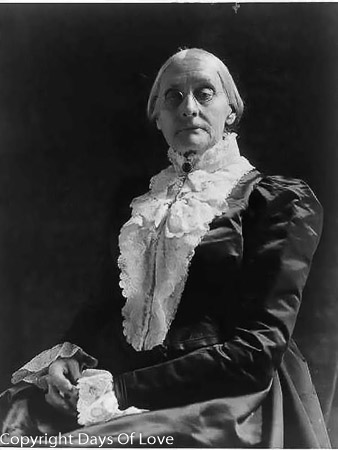

Queer Places:
Susan B. Anthony Birthplace Museum, 67 East Road, Adams, MA 01220, USA
Susan B. Anthony Childhood House, 2835 NY-29, Greenwich, NY 12834, Stati Uniti
Susan B. Anthony House, 17 Madison St, Rochester, NY 14608, Stati Uniti
Mount Hope Cemetery, 1133 Mt Hope Ave, Rochester, NY 14620, Stati Uniti
 Susan Brownell Anthony[1] (February 15, 1820 – March 13, 1906) was an American social reformer and women's rights activist who played a pivotal role in the women's suffrage movement. Born into a Quaker family committed to social equality, she collected anti-slavery petitions at the age of 17. In 1856, she became the New York state agent for the American Anti-Slavery Society.
Susan Brownell Anthony[1] (February 15, 1820 – March 13, 1906) was an American social reformer and women's rights activist who played a pivotal role in the women's suffrage movement. Born into a Quaker family committed to social equality, she collected anti-slavery petitions at the age of 17. In 1856, she became the New York state agent for the American Anti-Slavery Society.
In 1851, she met Elizabeth Cady Stanton, who became her lifelong friend and co-worker in social reform activities, primarily in the field of women's rights. In 1852, they founded the New York Women's State Temperance Society after Anthony was prevented from speaking at a temperance conference because she was female. In 1863, they founded the Women's Loyal National League, which conducted the largest petition drive in United States history up to that time, collecting nearly 400,000 signatures in support of the abolition of slavery. In 1866, they initiated the American Equal Rights Association, which campaigned for equal rights for both women and African Americans. In 1868, they began publishing a women's rights newspaper called ''The Revolution''. In 1869, they founded the National Woman Suffrage Association as part of a split in the women's movement. In 1890, the split was formally healed when their organization merged with the rival American Woman Suffrage Association to form the National American Woman Suffrage Association, with Anthony as its key force.
Although in 1865 Frances Dana Barker Gage was crippled when her carriage overturned in Galesburg, Illinois, she continued to lecture. Her addresses covered her "triune cause": first, abolition; second, women's rights; and third, temperance. The women's rights leaders and friends like Elizabeth Cady Stanton, Susan B. Anthony, Amelia Bloomer, Lucy Stone and Antoinette Brown encouraged Gage to be the women's rights emissary in America's midwest.[5] Her lecture circuit included Illinois, Indiana, Iowa, Massachusetts, Missouri, Nebraska, New York, Ohio and Pennsylvania, Louisiana, Mississippi, and Tennessee. In 1867 she spoke at the First Anniversary of the American Equal Rights Association.[11]

1896 photograph of Susan B. Anthony (center) and other women's rights leaders. Shaw sits to Anthony's immediate right.
In 1869, Mary Ann Shadd became the first woman to enter Howard University’s law school. She was the first African-American woman to obtain a law degree and among the first women in the United States to do so. She fought alongside Susan B. Anthony and Elizabeth Cady Stanton for women’s suffrage, testifying before the Judiciary Committee of the House of Representatives and becoming the first African-American woman to cast a vote in a national election.
In 1876, Anthony and Stanton began working with Matilda Joslyn Gage on what eventually grew into the six-volume ''History of Woman Suffrage''. The interests of Anthony and Stanton diverged somewhat in later years, but the two remained close friends.
In 1872, Anthony was arrested for voting in her hometown of Rochester, New York, and convicted in a widely publicized trial. Although she refused to pay the fine, the authorities declined to take further action. In 1878, Anthony and Stanton arranged for Congress to be presented with an amendment giving women the right to vote. Introduced by Sen. Aaron A. Sargent (R-CA), it later became known colloquially as the Susan B. Anthony Amendment. It was ratified as the Nineteenth Amendment to the U.S. Constitution in 1920.
Anna Howard Shaw first met Susan B. Anthony in 1887. In 1888, Shaw attended the first meeting of the International Council of Women.[8] Susan B. Anthony encouraged her to join the National Woman Suffrage Association (NWSA). Having agreed, Shaw played a key role when the two suffrage associations merged when she "helped to persuade the AWSA to merge with Anthony's and Elizabeth Cady Stanton's NWSA, creating for the first time in two decades a semblance of organizational unity within the [suffrage] movement."[8] Beginning in 1904 and for the next eleven years, Shaw was the president of NAWSA. Under her leadership, NAWSA continued to "lobby for a national constitutional amendment granting women the right to vote."[8] Lucy Elmina Anthony was the niece of Anthony and longtime companion of Shaw.[1]
Anthony traveled extensively in support of women's suffrage, giving as many as 75 to 100 speeches per year and working on many state campaigns. She worked internationally for women's rights, playing a key role in creating the International Council of Women, which is still active. She also helped to bring about the World's Congress of Representative Women at the World's Columbian Exposition in Chicago in 1893.
When she first began campaigning for women's rights, Anthony was harshly ridiculed and accused of trying to destroy the institution of marriage. Public perception of her changed radically during her lifetime, however. Her 80th birthday was celebrated in the White House at the invitation of President William McKinley. She became the first actual woman to be depicted on U.S. coinage when her portrait appeared on the 1979 dollar coin.
June Millington (born 1948), Lizzie Borden (1860-1927) and Susan B. Anthony (1820-1906), all descend from the same Pilgrims, Samuel Eddy and Constant Mitchell.

Tony Scupham-Bilton -
Mayflower 400 Queer Bloodlines
My published books: